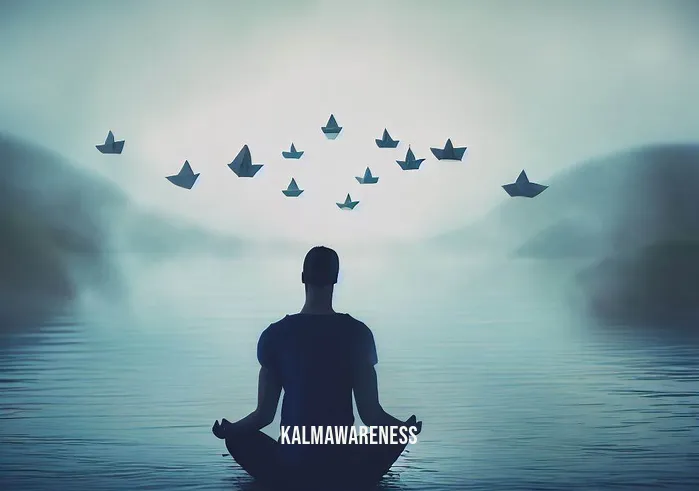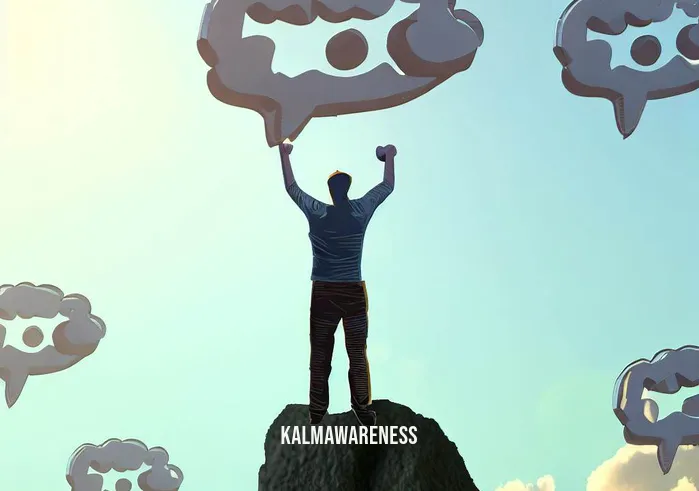The Journey Toward Mindfulness: Acceptance of Thoughts and Feelings
Introduction: Why Acceptance Matters
In the quest for mental well-being, the concept of acceptance of thoughts and feelings often remains overlooked. We’re educated from a young age to strive for success, to solve problems, and to overcome adversity. While these are valuable skills, they can sometimes make it difficult to simply be present with what is occurring within us. The mental gymnastics of dissecting every thought and emotion often leads to unnecessary stress and self-judgment.
Mindfulness practices encourage us to confront this paradox head-on, teaching us to embrace inner experiences with non-judgment. Doing so can improve our relationship with ourselves and foster compassion for others. In this segment, we will delve into what acceptance really means in the context of mindfulness and why it’s pivotal for cultivating mental well-being.
Acceptance Versus Resignation
One common misconception is that acceptance means resignation. Acceptance is not about giving up or relinquishing control; it’s about acknowledging the present state without fighting against it. In doing so, you cultivate a foundation for constructive action. If you’re stuck in traffic, railing against the situation won’t get you to your destination any faster. Accepting the situation doesn’t mean you’re content with being late; it means you’re choosing not to let the situation dictate your emotional state.
The Art of Non-Judgment
Learning to embrace inner experiences with non-judgment can be transformative. We often categorize our thoughts and feelings as “good” or “bad,” which can result in a perpetual cycle of self-criticism. This kind of thinking can be counterproductive and lead to heightened stress and anxiety.
“Judgments, criticisms, diagnoses, and interpretations of others are all alienated expressions of our needs.” – Marshall Rosenberg
Non-judgment involves recognizing thoughts and feelings as mere experiences, neither good nor bad. They are like clouds in the sky—constantly changing, and not defining the sky itself. This approach makes it easier to cultivate compassion for yourself and others.
Techniques for Cultivating Acceptance
- Breathing and Meditation: Mindfulness meditation often starts with focusing on your breath. The act of breathing serves as an anchor, bringing your focus back to the present whenever your mind wanders.
- Observation: Instead of reacting immediately to thoughts and feelings, practice observing them as they arise. This creates space for understanding and acceptance.
- Non-Identification: Thoughts and feelings are part of the human experience, but they do not define you. Practice non-identification by separating your sense of self from these transient experiences.
- Compassion: Cultivate compassion by recognizing the universality of human suffering. We all experience challenging thoughts and emotions. Being compassionate towards yourself makes it easier to extend that compassion to others.
Nurturing Mindful Presence with Thoughts and Feelings
At the core of mindfulness practice is the notion of staying present. Acceptance and presence go hand-in-hand. One cannot fully engage in the present moment without acknowledging and accepting what exists in that moment—be it good, bad, or neutral.
Learning to nurture mindful presence with thoughts and feelings is a lifelong journey. It requires practice, patience, and above all, a commitment to self-awareness and growth. If you’re interested in deepening your understanding of this practice and how it intersects with other aspects of mindfulness, continue reading to explore these themes further.

Advancing Through Acceptance: A More Comprehensive Understanding of Embracing Thoughts and Feelings
The Significance of Acceptance: Beyond Basic Understanding
As we move forward on this journey toward mental well-being, the importance of acknowledging and embracing thoughts and feelings cannot be overstated. In the previous chapter, we scratched the surface of what acceptance means and why it’s essential. However, the topic warrants further exploration. Acknowledgment, recognition, and reception of one’s internal experiences are not just methods to manage stress; they can be transformative avenues for growth and self-discovery.
The Complex Web of Inner Experiences
It is crucial to understand that our thoughts and emotions don’t exist in a vacuum. They are interconnected, influencing and being influenced by various factors such as external events, past experiences, and even our physiological state. This intricate web can make the practice of acceptance challenging but also incredibly rewarding.
Strategies for Advanced Practice
Mindful Journaling
- Writing down your thoughts and feelings can help you gain clarity and facilitate acceptance.
Acceptance and Commitment Therapy (ACT)
- This form of psychotherapy emphasizes the importance of accepting thoughts and feelings while committing to actions that align with personal values.
Scheduled Worry Time
- Allocate specific times to consciously think about your concerns, thereby allowing for structured periods of reflection and acceptance.
Table: Comparative Methods for Accepting Thoughts and Emotions
| Method | Primary Focus | Suitable For |
|---|---|---|
| Mindful Journaling | Self-reflection | Those who prefer written expressions |
| ACT | Therapeutic intervention | Individuals looking for a structured framework |
| Scheduled Worry Time | Time management | People with anxiety or obsessive thoughts |
| Breathing Techniques | Centering focus | Everyone |
| Compassionate Inquiry | Self-awareness | Those ready for deep emotional excavation |
Practical Applications: Real-world Contexts Where Acceptance Thrives
One might think that acceptance of thoughts and feelings is only applicable in controlled settings like a mindfulness class or therapist’s office. On the contrary, it’s incredibly versatile and can be applied in various contexts, from high-pressure professional environments to challenging personal situations. For instance, understanding and accepting one’s emotions can improve interpersonal relationships by enhancing empathy and reducing conflict.
Unveiling the Next Steps
In the realm of mindfulness, the sky’s the limit when it comes to the potential benefits of acceptance. As you delve deeper into this practice, you’ll encounter various tools and techniques designed to help you make peace with your inner world. In the next chapter, we’ll discuss how acceptance of thoughts and feelings dovetails with other mindfulness practices. We’ll look into the synergy between acceptance and mindfulness meditation, explore how acceptance can amplify the benefits of mindful breathing, and consider how these practices can not only change the individual but ripple out to make a positive impact on society.
Ready to go deeper? Continue reading to unlock the full potential of embracing your inner experiences.

The Inspirational Facet of Accepting Thoughts and Feelings: Harnessing the Power of Inner Peace
The Nourishing Impact of Acceptance on the Soul
As we deepen our exploration of acceptance, we begin to unveil its transformative power—not just as a tool for coping but as a source of inspiration and hope. Recognizing and acknowledging your inner experiences can illuminate a path filled with newfound purpose and meaning. When you allow yourself to make peace with your thoughts and feelings, you also pave the way for serenity and self-assurance.
Words of Wisdom: Quotes to Fuel Your Journey
Acceptance is not just a solitary experience but one that has been shared and contemplated by philosophers, scholars, and people from all walks of life. Here are some quotes that can serve as a beacon, shedding light on the value of accepting thoughts and feelings:
- “The only way to make sense out of change is to plunge into it, move with it, and join the dance.” – Alan Watts
- “The curious paradox is that when I accept myself just as I am, then I can change.” – Carl Rogers
- “Don’t let the behavior of others destroy your inner peace.” – Dalai Lama
- “You yourself, as much as anybody in the entire universe, deserve your love and affection.” – Sharon Salzberg
- “The wound is the place where the Light enters you.” – Rumi
These quotes encapsulate the transformative potential of acknowledging, receiving, and embracing your inner world.
Drawing Inspiration from Acceptance: Real-Life Stories
In previous chapters, we have laid the groundwork for understanding the technical aspects and methods related to accepting thoughts and emotions. Now, let’s look at some real-life stories where acceptance has led people to an inspiring transformation:
Emma’s Journey: Battling severe social anxiety, Emma found solace in mindfulness practices focused on acceptance. Instead of ruminating on her fears, she acknowledged them and used acceptance as a stepping stone to regain control of her life.
Daniel’s Awakening: Struggling with career dissatisfaction, Daniel discovered that resisting his feelings of unhappiness was exacerbating his condition. The moment he decided to accept these feelings, solutions began to surface, and he successfully transitioned into a more fulfilling job.
The Synergy of Acceptance and Hope
There is a magnetic relationship between the practice of acceptance and the emotion of hope. When you open your heart to your inner experiences without judgment, you create room for hope to blossom. Accepting your present state can make the future seem less daunting, as it often provides clarity and options for meaningful action. In essence, to accept is to hope, and to hope is to see the possibility of a brighter tomorrow.
Charting the Course Ahead
So far, we’ve seen how the acceptance of thoughts and feelings can be a transformative experience, serving as both a sanctuary for the mind and a source of inspiration. As you grow more comfortable with this practice, you may start to wonder how it can fit into the bigger picture of your mindfulness journey.
In the next chapter, we will venture into the interactive dimensions of acceptance, looking at how your internal peace can positively influence your interactions with the world around you. Ready to take the next leap? Continue reading to explore how acceptance can become your most potent tool for meaningful engagement with the world.

The Anatomy of Acceptance: Unpacking the Layers of Thoughts and Feelings
The Multifaceted Nature of Acceptance
We’ve ventured through the landscape of acceptance, examining its theoretical background, inspirational power, and practical applications. But to effectively practice the acceptance of thoughts and feelings, it’s beneficial to understand its structure—what it consists of, how it functions, and what dynamics come into play. In this chapter, we will dissect the concept, laying it out into its constituent elements for a more comprehensive understanding.
The Building Blocks of Acceptance
Acceptance is not a monolithic concept; it’s composed of various facets that collectively contribute to its efficacy. Here’s a breakdown:
Components of Acceptance
- Cognitive Recognition:
- Understanding the existence of a thought or feeling
- Emotional Validation:
- Acknowledging the legitimacy of your emotions
- Non-Judgmental Stance:
- Observing without labeling thoughts as ‘good’ or ‘bad’
- Conscious Choice:
- Deciding how to respond to the thought or emotion
- Action or Non-Action:
- Choosing to either act upon the emotion or let it pass
Phases of the Acceptance Process
- Initial Awareness:
- The moment you become conscious of a thought or emotion
- Reflection:
- The period where you examine the thought without judgment
- Decision-Making:
- Weighing your options for responding to the thought or emotion
- Implementation:
- Executing your choice in a mindful manner
- Re-assessment:
- Evaluating the results and recalibrating for future scenarios
Balancing Acceptance with Intentionality
Although the primary focus of acceptance is non-resistance and non-judgment, it’s also essential to balance this with intentional actions. Passive acceptance can lead to stagnation, while intentional acceptance propels you toward constructive outcomes.
Strategies for Intentional Acceptance
- Set Boundaries: Clearly define what you can and cannot control
- Prioritize Self-Care: Acceptance should nourish, not drain you
- Consult with Trusted Individuals: Sometimes, external perspectives can help in reinforcing acceptance
- Combine with Other Mindfulness Practices: Integrate acceptance with meditation, breathing exercises, or even physical activities like yoga
What Lies Ahead: A Sneak Peek into the Final Chapter
Throughout this journey, we’ve delved into the acceptance of thoughts and feelings from various angles—its significance, methods, inspirational facets, and structural elements. As we stand at the cusp of concluding this exploration, the final chapter promises to take you a step further. We’ll look into the cascading benefits of acceptance, not just for individual well-being but also for collective harmony. Intrigued by how the personal can become universal? Continue reading to find out.

The Closing Circle: Reflecting on the Odyssey of Acceptance
From Skepticism to Enlightenment: A Recap
What a journey it has been! Together, we’ve walked the labyrinthine path of acceptance, investigating its various dimensions, deconstructing its complexities, and highlighting its invaluable impact on our lives. At this point, it’s clear that acceptance of thoughts and feelings is not just a practice but a holistic way of living that empowers you to embrace life’s offerings, both good and bad, with grace and dignity.
The Mosaic of Acceptance: Piecing It All Together
Let’s take a moment to reflect on how the diverse elements we’ve explored contribute to the whole picture:
- Cognitive Awareness: The foundational pillar for any acceptance journey
- Inspirational Insights: The quotes and stories that fueled our understanding
- Structural Depth: Breaking down acceptance into manageable components
- Intentionality: The strategic alignment of acceptance with proactive life choices
Each piece adds richness and depth, forming a mosaic that’s as complex as it is beautiful.
A Toast to a Brighter Tomorrow
At the end of the day, the road to acceptance is about finding inner peace, cultivating self-compassion, and living authentically. As you grow comfortable acknowledging and validating your inner experiences, you open up new avenues for personal growth, happiness, and satisfaction.
Your Next Steps: Inviting Continuous Exploration
This might be the end of this series, but it’s hardly the end of your journey. The topic of acceptance is expansive and ever-evolving. We encourage you to:
- Revisit Previous Chapters: Sometimes a second look can offer new insights
- Engage with Other Content: Our magazine is chock-full of articles on mindfulness, mental health, and well-being
- Join Online Forums or Groups: Communities can offer support and fresh perspectives
- Practical Application: Remember, acceptance is a skill perfected through practice
A Heartfelt Thank You!
Thank you for sharing this enlightening voyage with us. Your time and engagement are invaluable, and we couldn’t be more grateful. Keep an eye out for more thought-provoking content in future editions, as we continue exploring the endless possibilities of human emotion and thought.
Before you go, we’d love to leave you with this simple yet profound thought: Acceptance isn’t the end but a new beginning, a gateway to a life lived fully, mindfully, and joyously.
So, why wait? Let’s keep the ball rolling, shall we?





